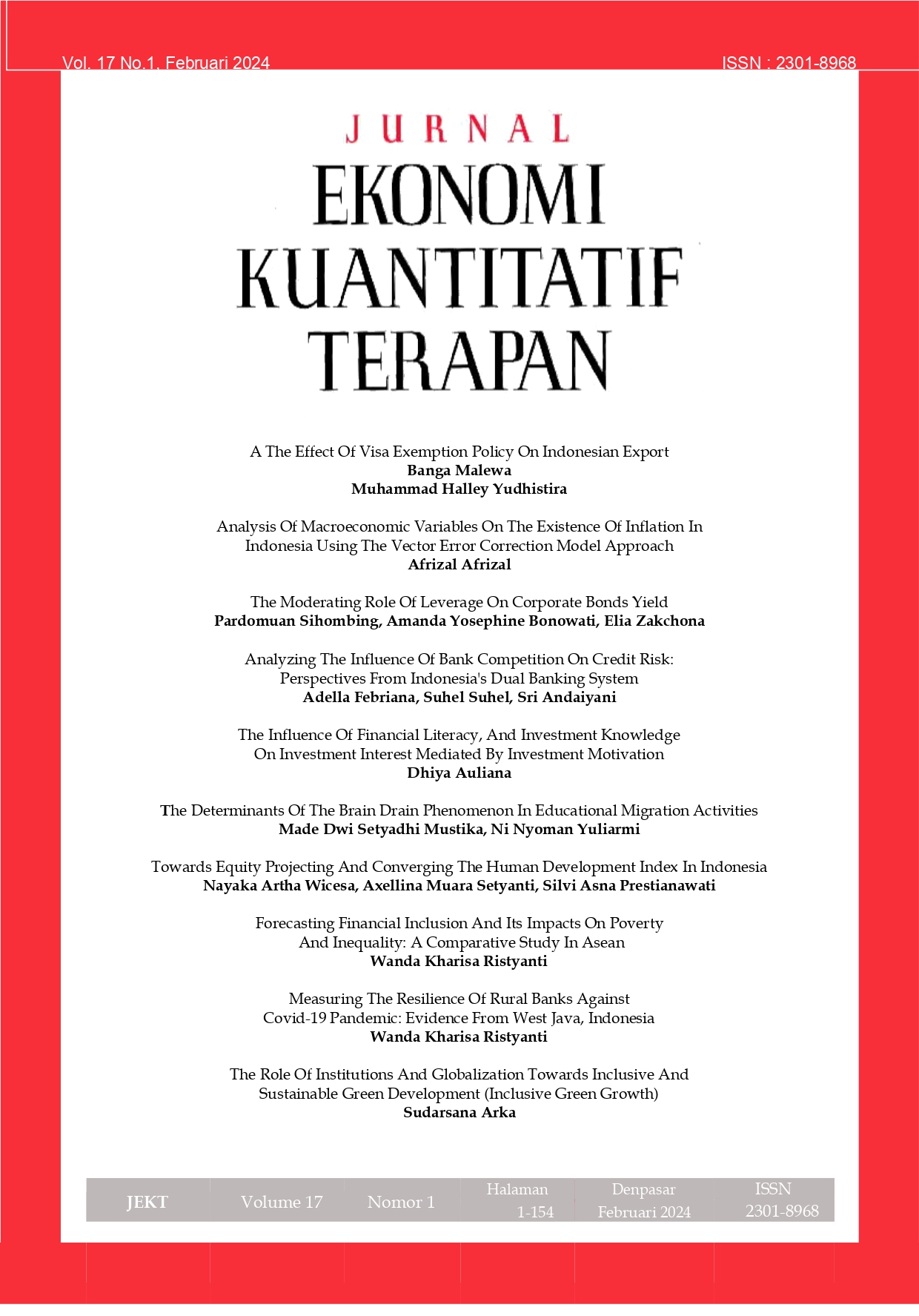Towards Equity Projecting and Converging the Human Development Index in Indonesia
-
Abstract
Human development has become an imperative for Indonesia amid the ongoing demographic bonus. However, various challenges persist in the realm of human development in the country, as evidenced by disparitie?s in Human Development Index (HDI) achievements. This research aims to project Indonesia's HDI for the years 2023, 2024, 2035, and the "Golden Indonesia" period in 2045 to discern the developmental trajectory of HDI and its disparities. Additionally, it seeks to measure the convergence of Indonesia's HDI to attain equitable development. The results of the trend projection estimations indicate that Indonesia's HDI is projected to be 73.74 in 2023 and 74.28 in 2024, which is anticipated to fall below the target set by the government, aiming for an HDI of 75.54 in 2024. Indonesia's HDI is projected to reach 80.22 in 2035 and 85.62 in 2045, categorizing it as 'Very High,' aligning with the vision for the Golden Indonesia in 2045. Furthermore, conditional convergence analysis results indicate that it would take 75 years for provinces with lower HDI to catch up with those with higher HDI, achieving zero inequality. Based on the estimation results, it is found that Per Capita Spending on Educational Functions is a significant variable influencing HDI convergence.
Keywords: Human Development Index, Disparity, Convergence, Projection
JEL Classification: C01, O11, O15
Downloads
References
Bahadir, B., & Valev, N., 2015. Financial development convergence. Journal of Banking & Finance, 56, 61-71.
Banerjee, A., Kuri, P. K., 2015. Regional disparity and convergence in human development in India. Development Disparities in India: An Enquiry into Convergence, 69-99.
Barro, R. and Sala-i-Martin, X., 1995. Economic Growth. McGraw Hill. New York.
Badan Pusat Statistik. 2022. Kependudukan. https://www.archive.bps.go.id/subject/12/kependudukan.html#subjekViewTab3
BAPPENAS. 2019. Ringkasan Eksekutif Visi Indonesia Emas. https://perpustakaan.bappenas.go.id/e-library/file_upload/koleksi/migrasi-data-publikasi/file/Policy_Paper/Ringkasan%20Eksekutif%20Visi%20Indonesia%202045_Final.pdf
Calderón, C., & Servén, L., 2014. Infrastructure, growth, and inequality: An overview. World Bank Policy Research Working Paper, (7034).
Citrawan, I. W., Widana, I. W., & Suarta, I., 2018. Education sector optimization for improving human development index. International Journal of Social Sciences and Humanities, 2(1), 117-133.
Coatsworth, J. H., 1996. Welfare. The American historical review, 101(1), 1-12.
Conradie, I., & Robeyns, I., 2013. Aspirations and human development interventions. Journal of Human Development and Capabilities, 14(4), 559-580.
Dasic, B., Devic, Z., Denic, N., Zlatkovic, D., Ilic, I. D., Cao, Y., ... & Le, H. V., 2020. Human development index in a context of human development: Review on the western Balkans countries. Brain and Behavior, 10(9), e01755.
Escosura, L. P. D. L., 2010. Improving human development: a long‐run view. Journal of Economic Surveys, 24(5), 841-894.
Fung, M. K., 2009. Financial development and economic growth: convergence or divergence?. Journal of international money and finance, 28(1), 56-67.
Ghislandi, S., Sanderson, W. C., & Scherbov, S., 2019. A simple measure of human development: The human life indicator. Population and development review, 45(1), 219.
Giuntini, G., 2015. Spillover Effects: Border Effect on Values of Human Development Index (HDI). Available at SSRN 2692266.
Kovacevic, M., 2010. Measurement of inequality in Human Development–A review. Measurement, 35, 1-65.
Lu, D., 2018. Rural-urban income disparity: impact of growth, allocative efficiency and local growth welfare. In Urbanization and Social Welfare in China (pp. 255-268). Routledge.
Mangaraj, B. K., & Aparajita, U., 2020. Constructing a generalized model of the human development index. Socio-Economic Planning Sciences, 70, 100778.
Marjit, S., Sasmal, R., & Sasmal, J., 2020. Composition of public expenditure and growth of per capita income in Indian states: a political perspective. Journal of Social and Economic Development, 22, 1-17.
Muliza, M., Zulham, T., & Seftarita, C., 2017. Analisis pengaruh belanja pendidikan, belanja kesehatan, tingkat kemiskinan dan PDRB terhadap IPM di provinsi Aceh. Jurnal Perspektif Ekonomi Darussalam (Darussalam Journal of Economic Perspec, 3(1), 51-69.
Noorbaksh, Farhad., 2023. Human Development and Regional Disparities in India. Presented in the United Nations World Institute for Development Economics Research Conference on Inequality, Poverty and Human Well-being, Helsinki., Finland 30-31 May 2003
Permanyer, I., & Smits, J., 2020. Inequality in human development across the globe. Population and Development Review, 46(3), 583-601.
Razmi, M. J., Abbasian, E., & Mohammadi, S., 2012. Investigating the effect of government health expenditure on HDI in Iran. Journal of Knowledge Management, Economics and Information Technology, 2(5).
Resce, G., 2021. Wealth-adjusted human development index. Journal of Cleaner Production, 318, 128587.
Royda, R., & Melvani, F. N., 2018. Pengaruh Belanja Pemerintah Untuk Pendidikan, Kesehatan, Infrastruktur Serta Pertanian Terhadap Pertumbuhan Ekonomi Di Kabupaten/Kota Provinsi Sumatera Selatan. Adminika, 4(1), 73–84.
Satrianto, A., & Juniardi, E., 2023. Inclusive Human Development and Inclusive Green Growth: A Simultaneous Approach. International Journal of Sustainable Development & Planning, 18(2).
Saudi, N. D. S., 2021. Analysis of Economic Growth and Income Disparity on Inter-Regional Welfare. Point of View Research Economic Development, 2(4), 68-87.
Shi, Z., & Tang, X., 2020. Exploring the new era: An empirical analysis of China’s regional HDI development. Emerging Markets Finance and Trade, 56(9), 1957-1970.
Szczepańska-Woszczyna, K., Gedvilaitė, D., Nazarko, J., Stasiukynas, A., & Rubina, A., 2022. Assessment of economic convergence among countries in the European Union. Technological and Economic Development of Economy, 28(5), 1572-1588.
UNDP. 2016. Human Development Report 2016. https://hdr.undp.org/content/human-development-report-2016?gad_source=1&gclid=CjwKCAiAvdCrBhBREiwAX6-6Unu0NG7IysJiR9v67M_3ld4dXZ0uhpSmMZhkx4JjPbi29DnmghOJFxoCitoQAvD_BwE
Wisnumurti, A. A. G. O., Darma, I. K., & Suasih, N. N. R. 2018. Government policy of Indonesia to managing demographic bonus and creating Indonesia gold in 2045. Journal Of Humanities And Social Science (IOSR-JHSS), 23(1), 23-34.
Wulandari, S., Dasopang, A. P., Rawani, G. A., Hasfizetty, I., Sofian, M. Y., Dwijaya, R., & Rachmalija, S. (2022). Kebijakan Anti Kemiskinan Program Pemerintah dalam Penananggulangan Kemiskinan di Indonesia. Jurnal Inovasi Penelitian, 2(10), 3209-3218.
Wu, S. Y., Tang, J. H., & Lin, E. S., 2010. The impact of government expenditure on economic growth: How sensitive to the level of development?. Journal of Policy Modeling, 32(6), 804-817.




















